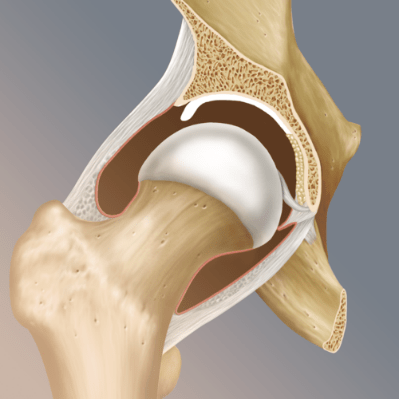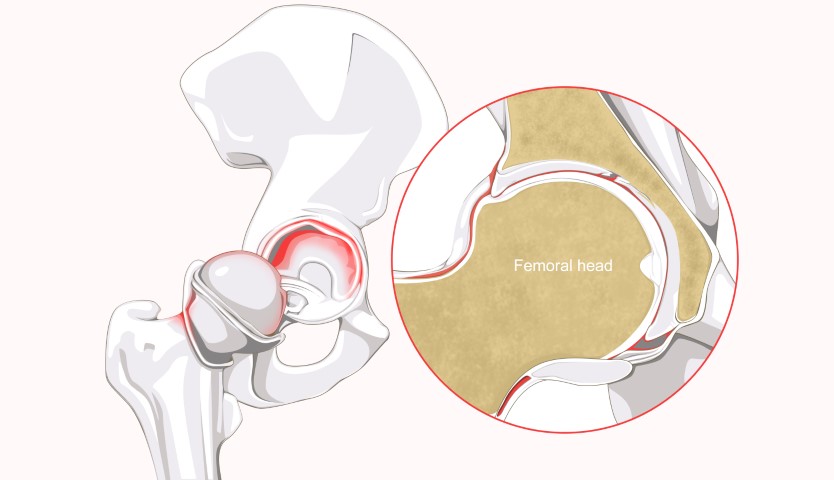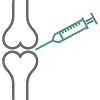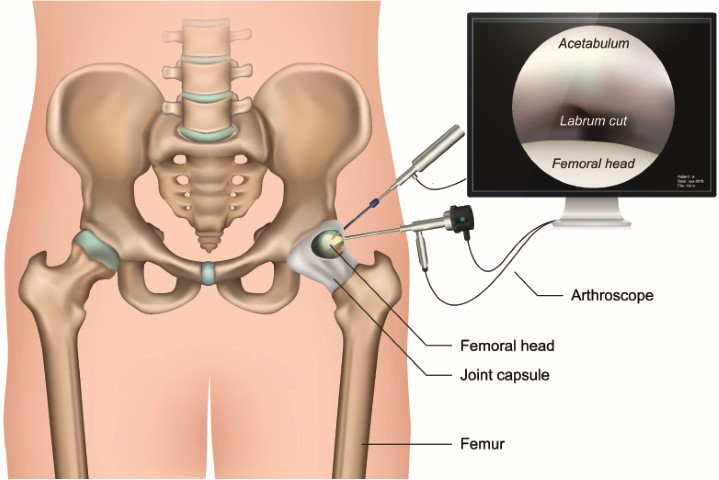What is a hip labral tear?
The hip joint is composed of a “ball and socket” joint, otherwise known as the femoral head and acetabulum, respectively. The labrum is a soft cartilage structure surrounding the socket. It acts as a cushion between the two bones and prevents fluid, called synovial fluid, from escaping from the joint . The labrum can be torn from its attachment anywhere on the socket, resulting in hip pain, limited function, and clicking or locking of the joint.
When seeking hip labral tear treatment, Melbourne residents can attend to the expertise of orthopaedic surgeon Dr Chandrasekaran at the MOATI clinic. Our team will diagnose your condition, treat your pain, and guide your recovery by creating a personalised treatment plan for you.
A torn labrum most commonly occurs in association with a traumatic injury. When the hip joint is injured, the labrum may tear, resulting in hip pain and reduced function. Multiple types of damage can happen to the labrum, such as:
- Degeneration - Wear and tear and general overuse of the labrum can result in the fraying or overall breakdown of the cartilage.
- Detachment - Traumatic injuries or conditions such as femoroacetabular impingement (FAI) can cause the labrum to tear or rupture.

The labrum could tear due to general wear and tear or as a result of direct impact trauma.
Causes of hip labral tears
Labral tears can occur at any age. Most commonly, these tears are caused by:
- Acute dislocations
- Twisting injuries or chronic, repetitive stresses to the joint
- Activities requiring repetitive hip movements (golf, dancing, gymnastics)
- Traumatic injury as a result of a fall or motor vehicle accident
- Sports injuries (most often contact sports)
- Developmental conditions (hip dysplasia, femoroacetabular impingement, slipped capital femoral epiphysis, etc)
Symptoms of hip labral tears
A tear in the labrum often results in instability of the hip joint, further damage to surrounding tissue, and over time, osteoarthritis. Most patients who have suffered a tear of the labrum may experience:
- deep groin pain.
- depending on the size of the tear, clicking or popping may be felt with certain hip motions.
- pain can occur with going up and downstairs, squatting or sitting on low chairs, sitting cross-leg, or prolonged sitting.
- locking sensation.
Diagnosis of a hip labral tear
Dr Chandrasekaran will perform a thorough history and physical exam, followed by medical imaging. The hip will be moved through a range of motion and stressed in certain ways to elicit pain or popping. X-rays may or may not show evidence of FAI (particularly Pincer lesions).
An MRI (with contrast dye) helps evaluate the labrum and assess further cartilage damage. Dr Chandrasekaran may also suggest minimally-invasive hip arthroscopy to evaluate the structures of the joint and determine if there is any bony abnormality on either the femoral head or the acetabulum if the diagnosis is unclear based on physical exam and MRI.

Our doctors will carry out all appropriate diagnostic tests to confirm your tear and establish whether there has been additional damage caused to surrounding bones and ligaments.
Treatment options for a hip labral tear
The treatment of choice for labral tears vary depending on personal characteristics and the necessity of surgery. First-line treatment involves conservative measures such as the prescription of anti-inflammatory medications and physical therapy with the aim of relieving pain. If conservative treatments are successful, then arthroscopic surgery may be required.

Non-Operative
Labral tears are sometimes misdiagnosed as tendon or muscle strains. Even if accurately diagnosed, Dr Chandrasekaran may use a number of conservative methods such as:
- prescribe anti-inflammatory medication
- physical therapy and activity modification to decrease pain and inflammation.
- injection of local anaesthetic or corticosteroid, which both confirms the diagnosis and decreases pain.
- injection of hyaluronic acid to improve joint lubrication
- trial of injections of protein-rich plasma to promote a healing response in the tissue
If the symptoms resolve, no further treatment is necessary.

Operative
The surgical procedure used to treat labral tears consists of minimally-invasive hip arthroscopy. Arthroscopic surgery, or keyhole surgery, involves the replacement or reconstruction of the abnormal hip structures through multiple smaller incisions.
- Dr Chandrasekaran can use a variety of techniques to repair the torn tissue, remove it or reconstruct the damaged tissue if the torn tissue is not amenable to repair. Repairing the tissue is completed with a series of sutures and anchors.
- If the tissue is reconstructed, a graft (from a donor) will be used in place of the damaged tissue and repaired to the bone with sutures and anchors. Postoperative medication and physical therapy are at Dr Chandrasekaran’s discretion.

The surgical procedure for a labral repair is minimally invasive and will produce minimal scarring.
How much does hip labral tear surgery cost?
Multiple factors contribute to the total cost of a hip labral tear surgery in Melbourne. The total cost also varies amongst individuals depending on their personal presentations and the respective treatment required to improve and manage their symptoms.
A total cost for your treatment will be given to you following your initial consultation with our orthopaedic surgeon, Dr Chandrasekaran. However, some additional costs that contribute to your final bill include:
- $200 initial consultation fee
- $100 follow-up consultation fee
- Cost of anesthetist
- Surgeon’s costs
- Cost of aftercare and involvement of the physiotherapy team
Why choose MOATI?
At MOATI, we believe that every patient deserves the same level of care and treatment as that of a professional athlete. Dr Siva Chandrasekaran and his team will go above and beyond to ensure that they treat you as a whole, establishing the factors limiting your ability to perform daily activities comfortably, and providing personalised treatment plans that can be accommodated into your daily routine.
Our orthopaedic surgeon, Dr Chandrasekaran has honed his specialty following the completion of multiple prestigious fellowships from the United Kingdom and Switzerland, where he has mastered the surgical artistry behind the knee and hip arthroscopy. To benefit from Dr Chandrasekaran’s expertise, contact us today to see how we can help.
The video below will demonstrate the surgical repair of a torn labrum.
FAQs
Below you can find answers to the most frequently asked questions revolving around the causes, diagnosis, and treatment of hip labral tears.
Tearing a labrum can feel different for each patient, although it is most painful and uncomfortable. Most patients feel pain around the front of the hip, groin, and even their thighs and buttocks.
Pain is accentuated during rotation, prolonged sitting, or climbing stairs. Some patients complain of hip joint instability accompanied by clicking or locking.
The surgery of choice for a labral repair is hip arthroscopy. This is a minimally-invasive procedure that involves the insertion of a small camera and surgical instruments to repair the damage caused to your labrum.
If your goal is to achieve reduced inflammation and pain and get back to carrying out physically demanding activities, then yes, a labral repair is worth it.
Patients who only have a minor tear in the labrum can recover within a few weeks with the help of conservative therapy.
Only minor tears can heal themselves. However, there is a risk of complete rupture if precautions are not taken.
Recovery varies between individuals. For most, complete recovery is achieved after 4-6 months. Office work can be returned to 2 weeks after surgery, and 6 weeks for physically demanding jobs.
Your physiotherapy team will guide you on the exercises you can and cannot do during your recovery. Follow-up consultations with Dr Chandrasekanda will assess your recovery and guide you to the next stages.
